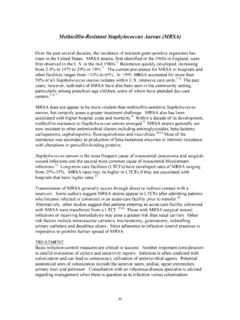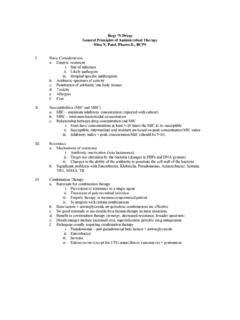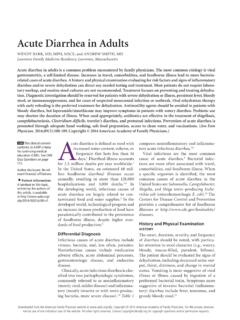Transcription of Eligibility Guide by Diagnosis
1 Care & Support Through the Stages of Serious Illness Guidelines for Hospice Eligibility It can be challenging to recognize when a patient could benefit from palliative care and hospice services. This booklet describes clinical guidelines for determining whether and when to refer a patient for palliative or hospice care. Referrals & Admissions: (800) 930-2770. Table of Contents Identifying a Primary Hospice 1. Amyotrophic Lateral Sclerosis (ALS).. 2. 3. Cerebral Vascular Accident/Stroke or 4. Dementia/Alzheimer' 5. Heart 6. HIV 7. Huntington's 8. Liver 9. Lung 10. Multiple Muscular 12. Parkinson's 13. Renal Failure 14. APPENDIX 1 NYHA Functional Classifications APPENDIX 2 Palliative Performance Scale (PPS). APPENDIX 3 Functional Assessment Staging (FAST). TABLE OF CONTENTS 3737 7/16. Identifying a Primary Hospice Diagnosis Determining a primary hospice Diagnosis can be challenging when a patient has some, but not all, of the clinical indicators of a specific disease or condition.
2 The following clinical signs often support hospice Eligibility in combination with another primary Diagnosis . 1. Rapid decline over the past three to six months, evidenced by: Rapid progression of disease Progressive decline in Palliative Performance Score (PPS)*. Weight loss not due to reversible causes and/or declining serum albumin levels Dependence on assistance for two or more ADLs: feeding, ambulation, continence, transfer, bathing or dressing 2. Dysphagia leading to inadequate nutritional intake or recurrent aspiration 3. Decline in systolic blood pressure to below 90 systolic or progressive postural hypotension 4. Increasing ER visits, hospitalizations or physician follow-up 5. Multiple progressive Stage 3 or Stage 4 pressure ulcers in spite of optimal care 6. Frequent falls or increasing problems with balance and weakness 7. Increased lethargy/sleepiness 8. Uncontrolled pain, shortness of breath, nausea/vomiting, anxiety 9.
3 Multiple, recurrent infections 10. Patient appears to be giving up physically and emotionally Agrace is available 24/7 to assist in identifying whether a patient may be eligible for hospice services. *See Appendix 2 for Palliative Performance Scale 1. Amyotrophic Lateral Sclerosis (ALS). The patient meets at least one of the following (1 or 2): 1. Severely impaired breathing capacity with all of the following findings: Dyspnea at rest Vital capacity less than 30%. Requirement for supplemental oxygen at rest The patient declines artificial ventilation OR. 2. Rapid disease progression with either a or b below: Rapid disease progression as evidenced by all of the following in the preceding 12 months: Progression from independent ambulation to wheelchair or bed-bound status Progression from normal to barely intelligible or unintelligible speech Progression from normal to pureed diet Progression from independence in most or all Activities of Daily Living (ADL) to needing major assistance by caretaker in all ADL.
4 A. Severe nutritional impairment demonstrated by all of the following in the preceding 12 months: Oral intake of nutrients and fluids insufficient to sustain life Continuing weight loss Dehydration or hypovolemia Absence of artificial feeding methods OR. b. Life-threatening complications demonstrated by one or more of the following in the preceding 12 months: Recurrent aspiration pneumonia (with or without tube feeding). Upper urinary tract infection (Pyelonephritis). Sepsis Recurrent fever after antibiotic therapy Stage 3 or Stage 4 pressure ulcer(s). In the absence of one or more of the above findings, rapid decline or comorbidities may also support Eligibility for hospice care. 2. Cancer The patient has 1, 2 and 3: 1. Clinical findings of malignancy with widespread, aggressive or progressive disease as evidenced by increasing symptoms, worsening lab values and/or evidence of metastatic disease 2.
5 Impaired performance status with a Palliative Performance Score (PPS) <70%*. 3. Refuses further curative therapy or continues to decline despite definitive therapy. Decline is evidenced by: Hypercalcemia 12. Cachexia or weight loss of 5% in the preceding three months Recurrent disease after surgery/radiation/chemotherapy Signs and symptoms of advanced disease, , nausea, anemia, malignant ascites or pleural effusion, etc. The following information will be required: 1. Tissue Diagnosis of malignancy OR. 2. Reason(s) why a tissue Diagnosis is not available In the absence of one or more of the above findings, rapid decline or comorbidities may also support Eligibility for hospice care. Concurrent therapy: Agrace may accept a patient for hospice while the patient continues to receive treatment (such as chemotherapy), under circumstances such as to meet a time-bound goal or for symptom management.
6 Please call Agrace to discuss patients who may need concurrent therapy. *See Appendix 2 for Palliative Performance Scale 3. Cerebral Vascular Accident/Stroke or Coma The patient has both 1 and 2: 1. Poor functional status with Palliative Performance Score of 40% or less (unable to care for self)*. AND. 2. Poor nutritional status with inability to maintain sufficient fluid and calorie intake with either: >10% weight loss over the previous six months > weight loss over the previous three months Serum albumin < gm/dl Current history of pulmonary aspiration without effective response to speech language pathology interventions to improve dysphagia and decrease aspiration events Supporting evidence for hospice Eligibility : Coma (any etiology) with three of the following on the third day of coma: Abnormal brain stem response Absent verbal responses Absent withdrawal response to pain Serum creatinine > gm/dl In the absence of one or more of these findings, rapid decline or comorbidities may also support Eligibility for hospice care.
7 *See Appendix 2 for Palliative Performance Scale 4. Dementia/Alzheimer's The patient has both 1 and 2: 1. Stage 7 or beyond according to the Functional Assessment Staging Scale (FAST)* with all of the following: Inability to ambulate without assistance Inability to dress without assistance Urinary and fecal incontinence, intermittent or constant No consistent meaningful/reality-based verbal communication, or the ability to speak is limited to a few intelligible words AND. 2. Has had at least one of the following conditions within the past 12 months: Aspiration pneumonia Pyelonephritis or other upper urinary tract infection Septicemia Pressure ulcers, multiple and/or Stage 3 or Stage 4. Fever, recurrent after antibiotics Inability to maintain sufficient fluid and caloric intake demonstrated by either of the following: a. 10% weight loss during the previous six months OR. b. Serum albumin < gm/dl In the absence of one or more of these findings, rapid decline or comorbidities may also support Eligibility for hospice care.
8 *See Appendix 3 for Functional Assessment Staging Scale 5. Heart Disease/CHF. The patient has 1 or 2 and 3: 1. Poor response to (or patient's choice is not to pursue) optimal treatment with diuretics, vasodilators and/or angiotensin converting enzyme (ACE) inhibitors OR. 2. The patient has angina pectoris at rest resistant to standard nitrate therapy and is not a candidate for invasive procedures and/or has declined revascularization procedures AND. 3. New York Heart Association (NYHA) Class IV symptoms with both of the following:*. The presence of significant symptoms of recurrent Congestive Heart Failure (CHF) and/or angina at rest Inability to carry out even minimal physical activity with symptoms of heart failure (dyspnea and/or angina). Supporting evidence for hospice Eligibility : Echo demonstrating an ejection fraction of 20% or less Treatment-resistant symptomatic dysrythmias History of unexplained or cardiac related syncope CVA secondary to cardiac embolism History of cardiac arrest or resuscitation In the absence of one or more of these findings, rapid decline or comorbidities may also support Eligibility for hospice care.
9 *See Appendix 1 for New York Heart Association (NYHA) Functional Classification 6. HIV Disease The patient has 1a or 1b, 2 and 3: 1a. CD4 + Count <25 cells/mm 3. OR. 1b. Persistent viral load > 100,000 copies/ml from two or more assays at least one month apart AND. 2. At least one of the following conditions: CNS lymphoma Untreated or refractory wasting (loss of >33% lean body mass). Mycobacterium avium complex (MAC) bacteremia, untreated, refractory or treatment refused Progressive multifocal leukoencephalopathy Systemic lymphoma Refractory visceral Kaposi's sarcoma Renal failure in the absence of dialysis Refractory cryptosporidium infection Refractory toxoplasmosis Treatment-resistant symptomatic dysrythmias History of unexpected or cardiac-related syncope CVA secondary to cardiac embolism History of cardiac arrest or resuscitation AND. 3. Palliative Performance Score of <50% (requires considerable assistance and frequent medical care, activity limited mostly to bed or chair)*.
10 Supporting evidence for hospice Eligibility : Chronic persistent diarrhea for one year Persistent serum albumin < Concomitant active substance abuse In the absence of one or more of these findings, rapid decline or comorbidities may also support Eligibility for hospice care. *See Appendix 2 for Palliative Performance Scale 7. Huntington's Disease The patient has both 1 and 2: 1. Stage 7 or beyond according to the Functional Assessment Staging Scale with all of the following:*. Inability to ambulate without assistance Inability to dress without assistance Urinary and fecal incontinence, intermittent or constant No consistent meaningful verbal communication AND. 2. Has had at least one of the following conditions within the past 12 months: Aspiration pneumonia Pyelonephritis or other upper urinary tract infection Septicemia Multiple Stage 3 or Stage 4 pressure ulcers Toxoplasmosis unresponsive to therapy Fever, recurrent after antibiotics Inability to maintain sufficient fluid and caloric intake with one or more of the following during the preceding 12 months: a.




